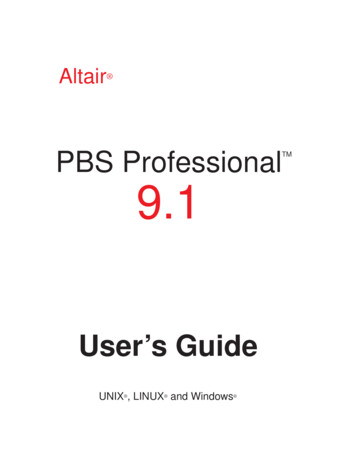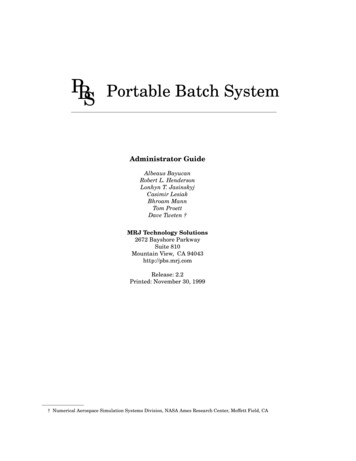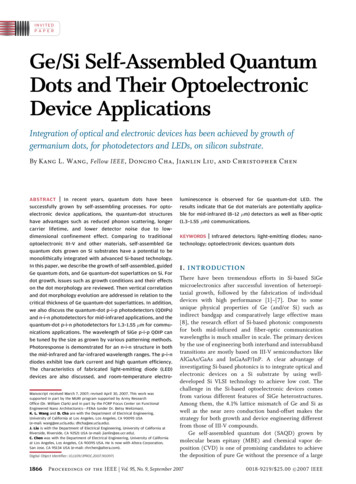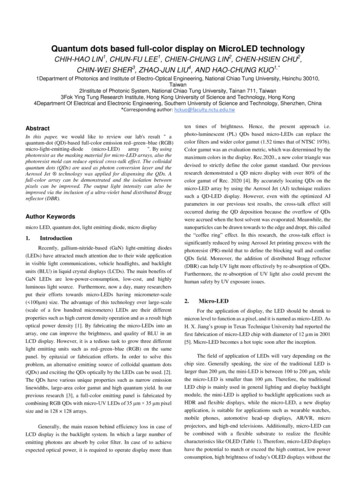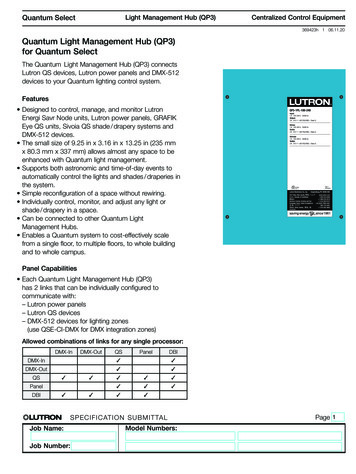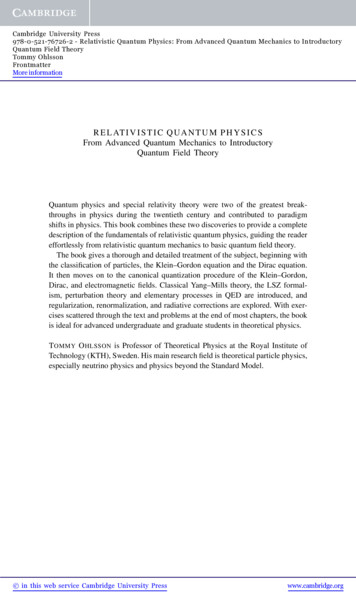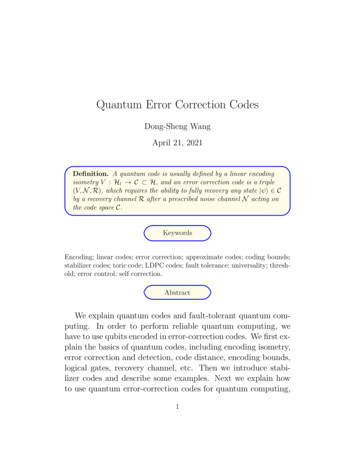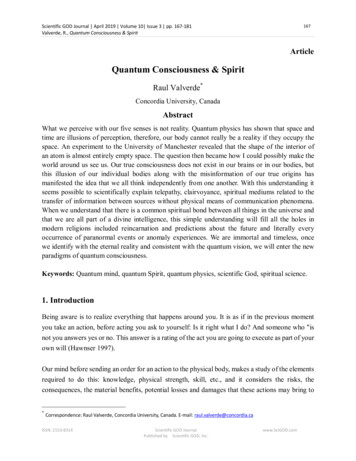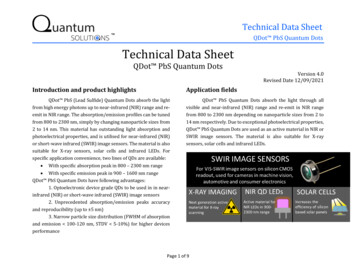
Transcription
Technical Data SheetQDot PbS Quantum DotsTechnical Data SheetQDot PbS Quantum DotsVersion 4.0Revised Date 12/09/2021Introduction and product highlightsApplication fieldsQDot PbS (Lead Sulfide) Quantum Dots absorb the lightfrom high energy photons up to near-infrared (NIR) range and reemit in NIR range. The absorption/emission profiles can be tunedfrom 800 to 2300 nm, simply by changing nanoparticle sizes from2 to 14 nm. This material has outstanding light absorption andphotoelectrical properties, and is utilised for near-infrared (NIR)or short-wave infrared (SWIR) image sensors. The material is alsosuitable for X-ray sensors, solar cells and infrared LEDs. Forspecific application convenience, two lines of QDs are available:QDot PbS Quantum Dots absorb the light through allvisible and near-infrared (NIR) range and re-emit in NIR rangefrom 800 to 2300 nm depending on nanoparticle sizes from 2 to14 nm respectively. Due to exceptional photoelectrical properties,QDot PbS Quantum Dots are used as an active material in NIR orSWIR image sensors. The material is also suitable for X-raysensors, solar cells and infrared LEDs. With specific absorption peak in 800 – 2300 nm range With specific emission peak in 900 – 1600 nm rangeQDot PbS Quantum Dots have following advantages:1. Optoelectronic device grade QDs to be used in in nearinfrared (NIR) or short-wave infrared (SWIR) image sensors2. Unprecedented absorption/emission peaks accuracyand reproducibility (up to 5 nm)3. Narrow particle size distribution (FWHM of absorptionand emission 100-120 nm, STDV 5-10%) for higher devicesperformancePage 1 of 9
Technical Data SheetQDot PbS Quantum DotsQDot PbS QDs selection guideQDot PbS Quantum Dots have a broad absorption profile, from high energyphotons up to NIR light. Looking closer in the NIR range reveals that QDs can becategorised according to their absorption profile (red line “Absorption”) or emissionprofile (purple line “Emission). Absorption profile is categorised according to the firstexcitonic absorption peak, the absorption FWHM and the peak-to-valley ratio.Emission profile is characterised by emission peak, emission FWHM and PLQY. Thedifference between the first excitonic absorption peak and emission peal is called astokes shift. Follow Table 1 to choose QDot materials based on absorption (abs)parameters, and Table 2 to choose QDot materials based on emission (em)parameters. QDot PbS QDs can be supplied as a solid paste/powder that is easilysoluble in octane or any other non-polar solvents (hexane, toluene, chloroform, chlorobenzene, dichlorobenzene) in a wide range ofconcentration up to 100-150 mg/mL. PbS QDs in a solution form (octane, toluene or other non-polar solvents) are also available.Page 2 of 9
Technical Data SheetQDot PbS Quantum DotsTable 1. Specification of QDot PbS Quantum Dots according to absorption (abs) peakPeak-tovalleyratioStokes shiftMaxsolubility innonpolarsolvents- 1.2 140 nm 150 mg/mLBlack paste 120 nm 1.5 120 nm 150 mg/mL35-45 wt%Black paste 120 nm 1.5 120 nm 150 mg/mLOleic acid35-45 wt%Black paste 120 nm 2 110 nm 100 mg/mL 4 nmOleic acid30-40 wt%Blackpowder 120 nm 3 100 nm 100 mg/mL1200 15 nm 4.5 nmOleic acid30-40 wt%Blackpowder 120 nm 4 90 nm 100 mg/mLPbS1300 15 nm 5 nmOleic acid30-40 wt%Blackpowder 120 nm 5 80 nmQDot PbS-1400-absPbS1400 15 nm 5.5 nmOleic acid25-35 wt%Blackpowder- Solid 100 mg/mL - Toluene 10 mg/mL- Octane 10 mg/mL 120 nm 5 70 nm 100 mg/mLQDot PbS-1420-absPbS1420 15 nm 5.5 nmOleic acid25-35 wt%Blackpowder 120 nm 5 70 nm 100 mg/mLQDot PbS-1500-absPbS1500 15 nm 6 nmOleic acid25-35 wt%Blackpowder 120 nm 6 50 nm 50 mg/mLQDot PbS-1520-absPbS1520 15 nm 6 nmOleic acid25-35 wt%Blackpowder 120 nm 6 50 nm 50 mg/mLQDot PbS-1600-absPbS1600 20 nm 6.5 nmOleic acid20-30 wt%Blackpowder 120 nm 6 40 nm 50 mg/mLQDot PbS-1700-absPbS1700 25 nm 7 nmOleic acid20-30 wt%Blackpowder 150 nm 3N/A 50 mg/mLCatalogue NumberCoretypeAbsorptionpeak (Abs 1)Average PbScore sizeCappingligandLigandFWHM ofconcentrati Appearance absorptionon(Abs 1)QDot PbS-800-absPbS800 15 nm 2.9 nmOleic acid40-50 wt%Black pasteQDot PbS-900-absPbS900 15 nm 3.2 nmOleic acid35-45 wt%QDot PbS-920-absPbS920 15 nm 3.2 nmOleic acidQDot PbS-1000-absPbS1000 15 nm 3.5 nmQDot PbS-1100-absPbS1100 15 nmQDot PbS-1200-absPbSQDot PbS-1300-absPage 3 of 9Form available
Technical Data SheetQDot PbS Quantum DotsQDot PbS-1800-absPbS1800 30 nm 8 nmOleic acid15-25 wt%Blackpowder 200 nm 2N/A 50 mg/mLQDot PbS-1900-absPbS1900 50 nm 8.5 nmOleic acid15-25 wt%Blackpowder 220 nm 1.5N/A50 mg/mLQDot PbS-2000-absPbS2000 50 nm 9 nmOleic acid10-20 wt%Blackpowder 220 nm 1.5N/A50 mg/mLQDot PbS-2100-absPbS2100 50 nm 10 nmOleic acid 15 wt%Blackpowder--N/A50 mg/mLQDot PbS-2200-absPbS2200 50 nm 11.5 nmOleic acid 15 wt%Blackpowder--N/A50 mg/mLQDot PbS-2300-absPbS2300 50 nm 14 nmOleic acid 15 wt%Blackpowder--N/A20 mg/mL- Solid- Octane 10 mg/mL- SolidQDot PbS Quantum Dots with different solvents, concentrations, emission and absorptions peaks are available upon request.Page 4 of 9
Technical Data SheetQDot PbS Quantum DotsOptical profiles of QDot PbS Quantum Dots according to absorption (abs) peakPage 5 of 9
Technical Data SheetQDot PbS Quantum DotsTable 2. Specification of QDot PbS Quantum Dots according to emission (em) peakCoretypeEmissionpeak(Abs 1)AveragePbS coresizeLigandCappingconcentrat AppearanceligandionFWHM ofemissionQDot PbS-900-emPbS900 25 nm 2.7 nmOleic acid 40-50 wt%Black paste 130 nm 120nmQDot PbS-1000-emPbS1000 25 nm 3.0 nmOleic acid 35-45 wt%Black paste 130 nm 110nmQDot PbS-1100-emPbS1100 25 nm 3.3 nmOleic acid 35-45 wt% Black powder 130 nm 100nmQDot PbS-1200-emPbS1200 25 nm 3.8 nmOleic acid 30-40 wt% Black powder 130 nmQDot PbS-1300-emPbS1300 25 nm 4.5 nmOleic acid 30-40 wt% Black powder 140 nmQDot PbS-1400-emPbS1400 25 nmOleic acid 30-40 wt% Black powder 140 nm 70 nmQDot PbS-1500-emPbS1500 25 nm 5.5 nmOleic acid 25-35 wt% Black powder 140 nm 50 nmQDot PbS-1600-emPbS1600 25 nmOleic acid 25-35 wt% Black powder 140 nm 40 nmCatalogue Number 5 nm 6 nm(Abs 1)PLQY(Abs 0.1)5-40%(seepage 6)StokesshiftForm available- Solid- Toluene 10 mg/mL 80 nm - Octane 10 mg/mL 90 nmQDot PbS Quantum Dots with different solvents, concentrations, emission and absorptions peaks are available upon request.Page 6 of 9
Technical Data SheetQDot PbS Quantum DotsOptical profiles of QDot PbS Quantum Dots according to emission (em) peakAbsorption profilesEmission profilesPLQY mapPage 7 of 9
Technical Data SheetQDot PbS Quantum DotsTEM imagesPage 8 of 9
Technical Data SheetQDot PbS Quantum DotsNotes for handlingShelf Life 12 months. Shipping temperature from 4-25 C. Storage temperature from 4-25 C. Store in DARK conditions, in original packagingor in airtight, sealed packaging inside a glovebox (under inert atmosphere). Repackage or dissolve in a glovebox only. Use anhydroussolvents only. Avoid contact with air.PbS QDs solids are easily soluble in octane, or any other non-polar solvents (hexane, toluene, chloroform, chlorobenzene, dichlorobenzene)in a wide range of concentrations up to 100-150 mg/mL (see Table 1). Dissolve in a glove box only. Use anhydrous solvents only. Filter thesolution by PTFE or PVDF filters before processing. Follow the video for the detailed guide how to dissolve the QDot PbS powders:https://www.youtube.com/watch?v -sLBZwA147cQUANTUM SOLUTIONS1 Venture Road, Southampton Science Park, SO16 7NP, Southampton, UKwww.quantum-solutions.comE-mail: info@quantum-solutions.com, Tel.: 44 73 89826941QDot is a trademark of QUANTUM SOLUTIONSPage 9 of 9
Qot PbS Quantum ots absorb the light through all visible and near-infrared (NIR) range and re-emit in NIR range from 800 to 2300 nm depending on nanoparticle sizes from 2 to 14 nm respectively. Due to exceptional photoelectrical properties, Qot PbS Quantum Dots are used as an active material in NIR or SWIR image sensors.

